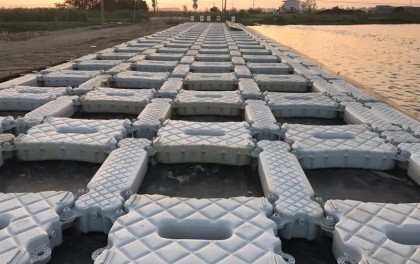According to the research on global photovoltaic market and technology, we predict that the following five photovoltaic innovative applications will become hot. From the perspective of application from near to far, we will take a look one by one at the five major trends of photovoltaic application in the future which are on the road of development.
No.1: Floating photovoltaic power station & floating photovoltaic solution
In our opinion, the floating photovoltaic power station may be the most mature new application field of photovoltaic besides the roof and ground power stations, which has attracted the attention of the global photovoltaic market. There are many successful cases of Sunshine Power and Three Gorges New Energy. The floating solar mounting system is also popular accordingly.
According to the research, if photovoltaic modules are installed on the surface of reservoirs or other water bodies. Due to the cooling effect of water, it can provide higher power generation efficiency and power generation capacity. The power generation capacity of photovoltaic modules can increase up to 10%. There are many other advantages. The most direct way is to reduce evaporation, prevent the generation of harmful algae and reduce the cost of water treatment. To this end, the industry has developed a term for this: Floatovoltaic - Float Photovoltaic.
Although by the end of 2017, the total installed capacity of photovoltaic power stations in the world has exceeded 500GW, however the installed capacity of floating photovoltaic power stations is only about 100MW.
In 2008, the first commercial 175kWh floating plate pv system was installed at one winery in Napa Valley, California.
In 2016, the largest single floating photovoltaic power station on the water surface in the world was Huainan 20MW project of sunshine power construction.

No.2: BIPV of photovoltaic building integration
As the name implies, the building integrated photovoltaic technology is to seamlessly integrate the photovoltaic system into the building system in the form of roof, canopy, curtain wall, facade and skylight system. Unlike traditional PV modules, the BIPV is attractive in architectural aesthetics, rather than a simple renovation of architectural design.
In addition to the building’s beauty, the economy is also important to the owners. The BIPV system can not only save the cost of building materials and electricity, but also realize the models of low-carbon or zero carbon buildings. It helps owners apply for various government subsidies and awards. Replacing standard building materials with BIPV can reduce the additional cost of solar panel installation system. It is also the market strategy of BIPV PV suppliers: the BIPV is not sold as pv, but as a new building material.
BIPV technology has the following advantages when it is applied in facade, atrium, terrace floor and roof of buildings:
Improving energy efficiency
High thermal insulation and sound insulation
Clean and free solar output
Reduce operation and maintenance costs
Zero carbon footprint
As a building material, photovoltaic glass not only plays the role of power generation, but also does not block the sunlight, which is just like the traditional building glass.
No.3: Solar skin
The solar skin is a new photovoltaic technology, which integrates customized design into the solar panel system as the shell of buildings, cars, toys and other items. The solar skin technology can do the same thing as advertising on a car window.
According to the information, the solar film on the solar skin has selective filtering performance. The progress of technology makes photovoltaic system not only keep high efficiency, but also produce good visual effects. The sunlight on the solar skin is filtered, and some wavelengths selectively pass through the solar cells below to generate electricity, while the other wavelength of light is reflected to display a custom image. These engraved custom images, embedded in solar panels, can exactly match the lawn or roof of your home.
The application of the solar skin also allows enterprises or government departments to customize the display of business signs, commercial advertisements, national flag, etc.
It is reported that the United States National Renewable Energy Laboratory is testing the technology to improve its efficiency. In addition, the solar skin technology does not need solar mountings. It can cling to the substrate, has a smooth appearance and hides all metal parts. And the metal components look cool. The disadvantage of solar skin is its cost.
No.4: Solar Fabric
Solar radiation spreads all over the earth, so you can generate electricity on your own. Imagine that the electricity can be generated on your clothes and backpacks. The solar fabric here is not limited to the solar wearable products promoted by the enterprises such as Hanergy. Recent research shows that solar energy is envisioned in every fabric fiber. These solar fibers can be embedded in your T-shirt, winter coat or any other clothing to help keep you warm, power your phone, and power other needs on your journey.
The combination of solar fabrics and solar panels may include:
Building façade: it can provide shadows and power generation.
Awning: it can light up the street lamp.
Curtain: it can open and close by it self.
Solar household clothing
No.5: PV Noise Banner
The traffic noise of expressway and elevated road is a major interference to environment and residents. We can see that there are traffic noise barriers on both sides of the city's elevated roads, tunnel exits and expressways passing through residential areas. The construction of noise barriers is an additional cost for road construction. The design should not only effectively isolate the noise, but also reduce the cost as much as possible.
If the noise control can be combined with sustainable power generation, it will bring not only social benefits, but also economic benefits. The national and global road resources are huge for photovoltaic applications.
Given the widespread use of noise barriers in the United States, the potential for solar energy production from these barriers could be about 400 gigawatt hours (GWh) per year. That's about 37, 000 households' annual electricity consumption.
